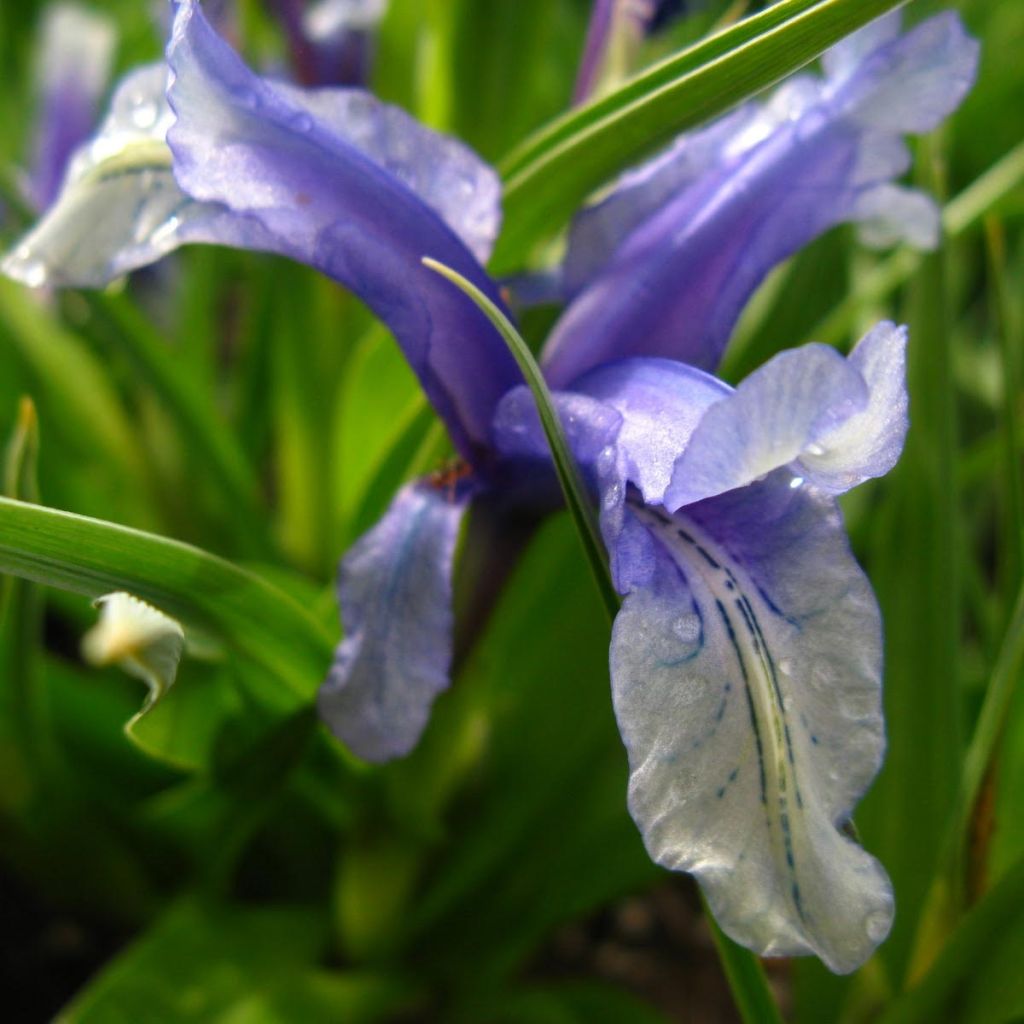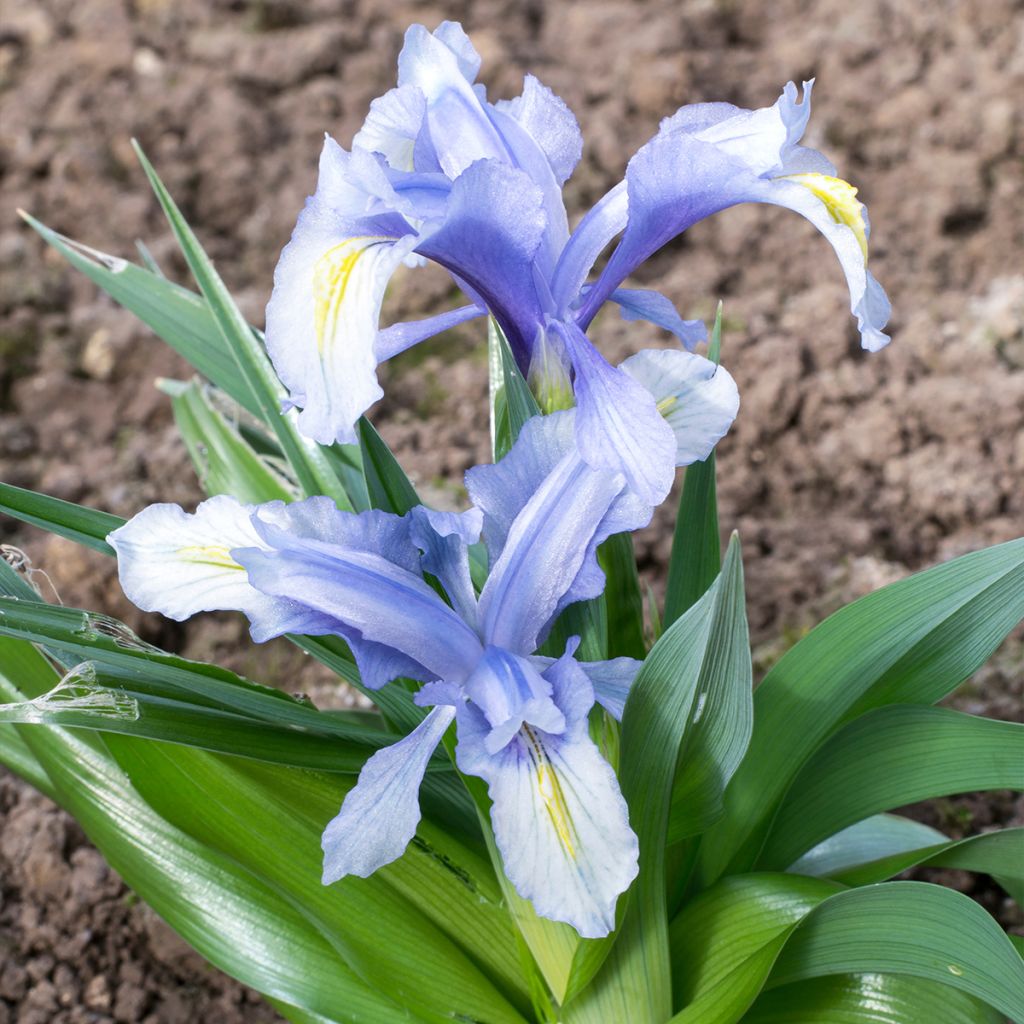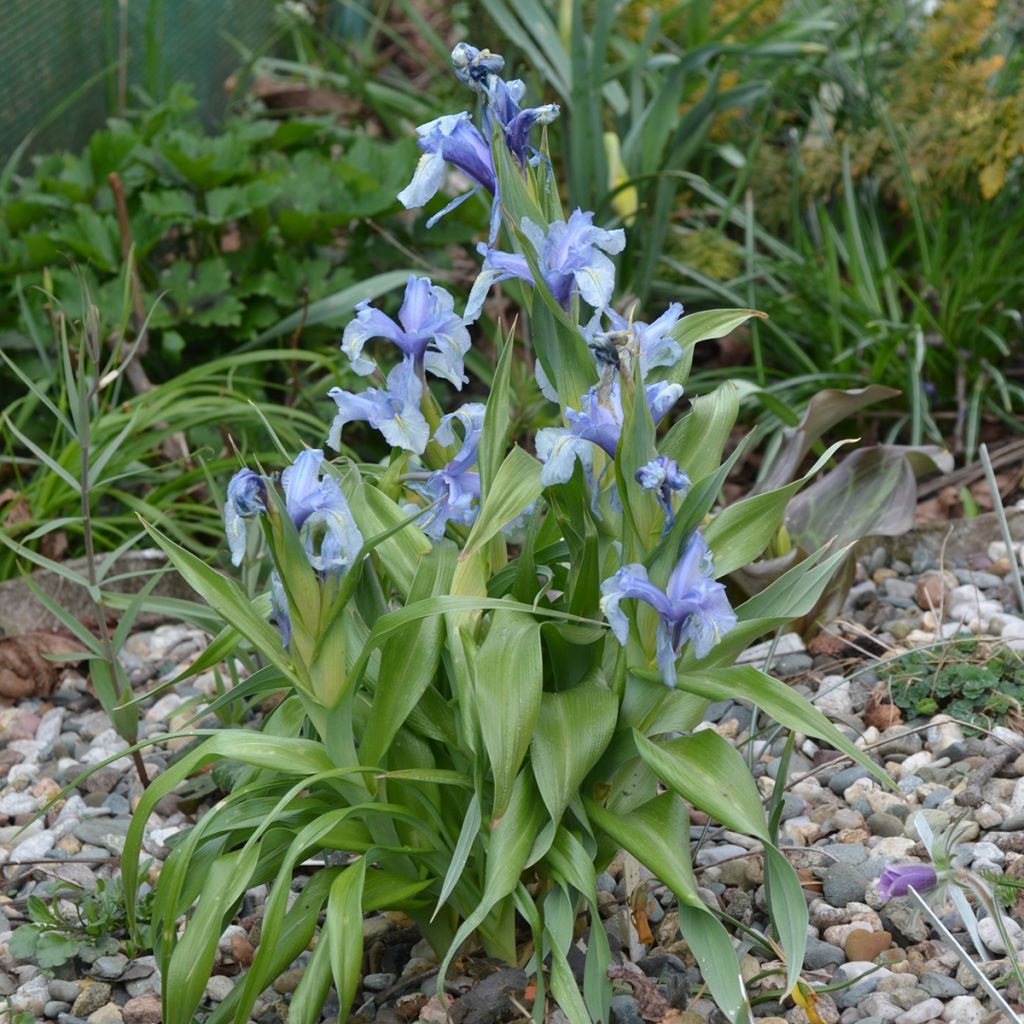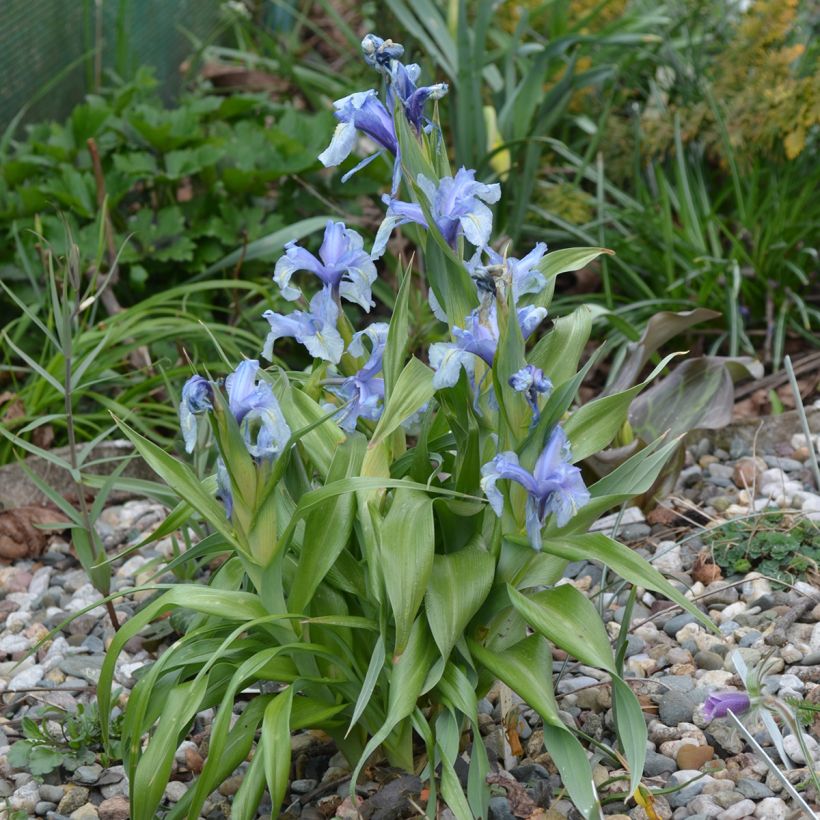

Iris aucheri - Iris botanique


Iris aucheri - Iris botanique


Iris aucheri - Iris botanique
Iris aucheri
Iris aucheri
Aucher's Iris
This plant carries a 6 months recovery warranty
More information
We guarantee the quality of our plants for a full growing cycle, and will replace at our expense any plant that fails to recover under normal climatic and planting conditions.
From €5.90 for pickup delivery and €6.90 for home delivery
Express home delivery from €8.90.
Does this plant fit my garden?
Set up your Plantfit profile →
Description
The Iris aucheri is a vigorous small botanical species originating from the Middle East that blooms in spring in sunny rock gardens. It is a bulbous, perennial and hardy iris, which will be appreciated, as soon as the first beautiful days come, for its blue to white flowers enhanced with yellow. In mild weather, they exude a sweet violet fragrance. It is easily cultivated in well-drained, rocky or stony soils, in full sun.
The Iris aucheri, sometimes called Aucher-Eloy Iris, is native to northern Iraq, southeastern Turkey, northern Syria, western Iran, and Jordan. It is classified in the Juno iris group, which have the characteristic of producing multiple flower stems per bulb. The underground storage organ is a bulb with large fleshy roots, not a rhizome like their famous cousins, the German Iris or Garden Iris. Belonging to the same botanical family as the latter, the iridaceae family, they also differ from them by the absence of "beards", those pretty little fluffy and colourful tongues found on the drooping sepals of the German Iris. On the other hand, they have decorative crests crossing each of the sepals.
The foliage of the Iris aucheri emerges from the ground in late winter, in February-March. It is composed of numerous lanceolate leaves, short and quite wide, slightly shiny, bright green in colour, somewhat resembling small corn leaves. The flowering takes place in April-May, more or less early depending on the climate. From the foliage emerge short flower stems each bearing one or two clusters of flowers, at 25 cm (10in) above the ground. Each flower is composed of 3 discreet petals surmounting 3 wider and drooping sepals, adorned with a bright yellow crest. From the heart of the flower also emerge 3 decorative styles resembling petals. The colour of the flower varies from light blue to slate lilac and white depending on the strains. The foliage dries up in early summer, marking the plant's entry into a dormant phase. During this period, the soil should be dry.
The Iris aucheri is perfect in rock gardens, borders, raised beds, or even to decorate ephemeral flowering pots, to bring inside the house to fully enjoy its fragrance. It pairs well with iris pumila, botanical crocus, or blanda anemones for example. Let the bulbs naturalize in well-drained soil, they will form beautiful clumps after a few years, announcing the return of spring. This plant experiences cold and sometimes snowy winters, rather dry, but also hot and dry summers in its native range. Therefore, it will be easily adopted in montane and rocky gardens, or in a dry garden.
Report an error about the product description
Iris aucheri in pictures




Plant habit
Flowering
Foliage
Botanical data
Iris
aucheri
Iridaceae
Aucher's Iris
Middle East
Planting and care
Plant the bulbs in September-October, in a sunny location, in a well-drained soil (even sandy or rocky), fertile, preferably neutral to slightly alkaline. Add some coarse sand or compost to your soil if necessary. Plant the bulbs 10 cm (4in) deep, spaced 30 cm (12in) apart. Water well to promote establishment. Once established, the Iris aucheri will thrive without any watering in all our regions. Leave the bulbs in place for several years. This iris rests in summer, preferably in a dry soil. Its bulb dislikes wet soils during the summer resting period, as well as in winter.
Divide the clumps after 4 to 5 years, when they seem less floriferous. Do this once the leaves have dried, at the beginning of the resting period.
The leaves of the Iris aucheri should only be cut once they are dry; they allow the bulb to replenish its reserves for the following spring flowering. Remove the pods when they form, so that the plant does not exhaust itself producing seeds.
Planting period
Intended location
Care
This item has not been reviewed yet - be the first to leave a review about it.
Haven't found what you were looking for?
Hardiness is the lowest winter temperature a plant can endure without suffering serious damage or even dying. However, hardiness is affected by location (a sheltered area, such as a patio), protection (winter cover) and soil type (hardiness is improved by well-drained soil).

Photo Sharing Terms & Conditions
In order to encourage gardeners to interact and share their experiences, Promesse de fleurs offers various media enabling content to be uploaded onto its Site - in particular via the ‘Photo sharing’ module.
The User agrees to refrain from:
- Posting any content that is illegal, prejudicial, insulting, racist, inciteful to hatred, revisionist, contrary to public decency, that infringes on privacy or on the privacy rights of third parties, in particular the publicity rights of persons and goods, intellectual property rights, or the right to privacy.
- Submitting content on behalf of a third party;
- Impersonate the identity of a third party and/or publish any personal information about a third party;
In general, the User undertakes to refrain from any unethical behaviour.
All Content (in particular text, comments, files, images, photos, videos, creative works, etc.), which may be subject to property or intellectual property rights, image or other private rights, shall remain the property of the User, subject to the limited rights granted by the terms of the licence granted by Promesse de fleurs as stated below. Users are at liberty to publish or not to publish such Content on the Site, notably via the ‘Photo Sharing’ facility, and accept that this Content shall be made public and freely accessible, notably on the Internet.
Users further acknowledge, undertake to have ,and guarantee that they hold all necessary rights and permissions to publish such material on the Site, in particular with regard to the legislation in force pertaining to any privacy, property, intellectual property, image, or contractual rights, or rights of any other nature. By publishing such Content on the Site, Users acknowledge accepting full liability as publishers of the Content within the meaning of the law, and grant Promesse de fleurs, free of charge, an inclusive, worldwide licence for the said Content for the entire duration of its publication, including all reproduction, representation, up/downloading, displaying, performing, transmission, and storage rights.
Users also grant permission for their name to be linked to the Content and accept that this link may not always be made available.
By engaging in posting material, Users consent to their Content becoming automatically accessible on the Internet, in particular on other sites and/or blogs and/or web pages of the Promesse de fleurs site, including in particular social pages and the Promesse de fleurs catalogue.
Users may secure the removal of entrusted content free of charge by issuing a simple request via our contact form.
The flowering period indicated on our website applies to countries and regions located in USDA zone 8 (France, the United Kingdom, Ireland, the Netherlands, etc.)
It will vary according to where you live:
- In zones 9 to 10 (Italy, Spain, Greece, etc.), flowering will occur about 2 to 4 weeks earlier.
- In zones 6 to 7 (Germany, Poland, Slovenia, and lower mountainous regions), flowering will be delayed by 2 to 3 weeks.
- In zone 5 (Central Europe, Scandinavia), blooming will be delayed by 3 to 5 weeks.
In temperate climates, pruning of spring-flowering shrubs (forsythia, spireas, etc.) should be done just after flowering.
Pruning of summer-flowering shrubs (Indian Lilac, Perovskia, etc.) can be done in winter or spring.
In cold regions as well as with frost-sensitive plants, avoid pruning too early when severe frosts may still occur.
The planting period indicated on our website applies to countries and regions located in USDA zone 8 (France, United Kingdom, Ireland, Netherlands).
It will vary according to where you live:
- In Mediterranean zones (Marseille, Madrid, Milan, etc.), autumn and winter are the best planting periods.
- In continental zones (Strasbourg, Munich, Vienna, etc.), delay planting by 2 to 3 weeks in spring and bring it forward by 2 to 4 weeks in autumn.
- In mountainous regions (the Alps, Pyrenees, Carpathians, etc.), it is best to plant in late spring (May-June) or late summer (August-September).
The harvesting period indicated on our website applies to countries and regions in USDA zone 8 (France, England, Ireland, the Netherlands).
In colder areas (Scandinavia, Poland, Austria...) fruit and vegetable harvests are likely to be delayed by 3-4 weeks.
In warmer areas (Italy, Spain, Greece, etc.), harvesting will probably take place earlier, depending on weather conditions.
The sowing periods indicated on our website apply to countries and regions within USDA Zone 8 (France, UK, Ireland, Netherlands).
In colder areas (Scandinavia, Poland, Austria...), delay any outdoor sowing by 3-4 weeks, or sow under glass.
In warmer climes (Italy, Spain, Greece, etc.), bring outdoor sowing forward by a few weeks.
































